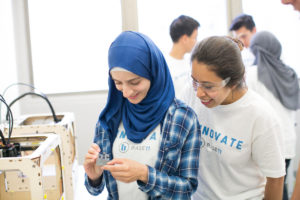Community colleges are stepping up to the plate to become STEM Accelerators that attract and retain more students to STEM fields, and prepare them for success in STEM 2.0.
It’s no secret that growth in STEM jobs — a broad category including science, technology, engineering and math — is outpacing all other fields. The US expects about 9 million new STEM jobs by 2022, according to a report from the Bureau of Labor Statistics. But based on the rate at which we’re currently producing new STEM workers, we’re going to fall short by about 1 million.
Here are a few programs you can implement to make your campus a STEM accelerator:
1. Expose students to research universities
 Exposing students at the community college level to summer research experiences at four-year colleges can have a major impact. In one study, 75% of community college students who conducted summer research on a 4-year college campus ended up transferring to STEM degrees.
Exposing students at the community college level to summer research experiences at four-year colleges can have a major impact. In one study, 75% of community college students who conducted summer research on a 4-year college campus ended up transferring to STEM degrees.
Over the summer East LA Community College Francisco Gomez did graduate-level engineering research at nearby University of Southern California. “The program sparked my curiosity for research,” says Gomez. “It’s more plausible for me to go to graduate school now.” He went on to transfer to the University of California, Irvine to pursue a bachelor’s in engineering.
2. Create a makerspace
 A makerspace is a dedicated facility with special equipment like 3D printers, laser cutters, and design software that enables users to design and create almost anything they can dream up. The Fab Lab — short for fabrication laboratory — is the model that originated at MIT. Currently 30 community colleges have on-campus Fab Labs, bringing Ivy league-quality resources to their students.
A makerspace is a dedicated facility with special equipment like 3D printers, laser cutters, and design software that enables users to design and create almost anything they can dream up. The Fab Lab — short for fabrication laboratory — is the model that originated at MIT. Currently 30 community colleges have on-campus Fab Labs, bringing Ivy league-quality resources to their students.
Plenty of research shows that hands-on experiences, such as those in a makerspace, help sustain students interest in STEM fields. According to the Fab Foundation, “Fab Labs are increasingly being adopted by schools as platforms for project-based, hands-on STEM education” where “learning happens in an authentic, engaging, personal context.”
3. Empower emerging entrepreneurs
 There are many paths to STEM success, and not all of them require a college degree. Steve Jobs, Michael Dell and Richard Branson are just a few of the wildly successful, risk-taking entrepreneurs who dropped out. With the rise of the maker movement, colleges are wise to foster the entrepreneurial spirit of bold thinkers in the community. Entrepreneurial training can help integrate makerspaces into the curriculum. In addition to training students to use Fab Lab equipment, these classes teach the entrepreneurial mindset, leadership skills, how to create a business plan, marketing and sales fundamentals, and tips to secure funding to bring their ideas to market.
There are many paths to STEM success, and not all of them require a college degree. Steve Jobs, Michael Dell and Richard Branson are just a few of the wildly successful, risk-taking entrepreneurs who dropped out. With the rise of the maker movement, colleges are wise to foster the entrepreneurial spirit of bold thinkers in the community. Entrepreneurial training can help integrate makerspaces into the curriculum. In addition to training students to use Fab Lab equipment, these classes teach the entrepreneurial mindset, leadership skills, how to create a business plan, marketing and sales fundamentals, and tips to secure funding to bring their ideas to market.
4. Match up mentors with students
 Mentorship is gaining visibility as a way to retain women and minorities in STEM fields. Students at the community college level need to see peers whom they can relate to succeeding in STEM not only on their campus, but at four-year colleges and in the workplace. You can explore formal mentorship programs like Million Women Mentors or turn to professional societies like the Society of Hispanic Professional Engineers that offers networking and informal mentorship opportunities for students. You might explore partnerships with local businesses that have an interest in hiring future STEM graduates.
Mentorship is gaining visibility as a way to retain women and minorities in STEM fields. Students at the community college level need to see peers whom they can relate to succeeding in STEM not only on their campus, but at four-year colleges and in the workplace. You can explore formal mentorship programs like Million Women Mentors or turn to professional societies like the Society of Hispanic Professional Engineers that offers networking and informal mentorship opportunities for students. You might explore partnerships with local businesses that have an interest in hiring future STEM graduates.
Don’t underestimate the power of your own staff and faculty in serving as mentors. “The female faculty members in my department served as professors, role models, and mentors for me as an undergraduate student,” says Leslie McCollum, Ph.D. “Because of my successful female role models in physics, I didn’t doubt whether or not I belonged.”
5. Train for middle-skill jobs
 Often missing from conversation about training the future STEM workforce is the need for middle-skill employees. According to policy think-tank RAND, “middle-skill STEM jobs that require associate’s degrees or occupational certifications—such as computer support specialists, web developers, and engineering technicians—are in the highest demand” of all STEM occupations.
Often missing from conversation about training the future STEM workforce is the need for middle-skill employees. According to policy think-tank RAND, “middle-skill STEM jobs that require associate’s degrees or occupational certifications—such as computer support specialists, web developers, and engineering technicians—are in the highest demand” of all STEM occupations.
This creates a unique opportunity for community colleges. San Francisco Community College, adjacent to the Silicon Valley, is currently partnering with nonprofits and local companies through the Springboard Initiative to provide training for very specific tech support and software development jobs that need to be filled in locally.
If you want help making your campus a STEM accelerator, contact info@base11.com.

